Introduction
The Age of Exploration was a defining period in world history that reshaped civilizations, economies, and cultures across continents. European powers, driven by ambition, curiosity, and necessity, embarked on transoceanic voyages that would forever alter the course of human history. The quest for wealth, territorial expansion, and religious influence led to the discovery and eventual colonization of the America. This chapter explores the key factors that prompted European exploration, the motivations behind their expeditions, and the major players involved in this transformative era.
Setting the Stage: Why Europe Turned to Exploration
By the late 15th century, Europe was emerging from the medieval era, marked by economic revival, technological advancements, and shifting political landscapes. Several factors contributed to the newfound zeal for exploration:
The Fall of Constantinople and the Search for New Trade Routes
In 1453, the Ottoman Empire captured Constantinople, cutting off European access to the lucrative Silk Road trade routes to Asia. This event forced European nations to seek alternative paths to acquire valuable commodities such as spices, silk, and precious metals. Maritime exploration became a strategic necessity to bypass Ottoman-controlled territories and establish direct trade links with Asia.
Advances in Navigation and Shipbuilding
The Renaissance ushered in a wave of scientific progress, leading to significant advancements in navigation and ship design. The development of the magnetic compass, the astrolabe, and improved cartography enabled sailors to traverse vast oceans with greater accuracy. The introduction of the caravel, a highly maneuverable ship, allowed explorers to venture farther into uncharted waters, making transatlantic voyages feasible.
Political Competition and the Rise of Nation-States
The consolidation of powerful European monarchies, such as Spain, Portugal, France, and England, fueled an intense rivalry for global dominance. Monarchs sought to expand their empires, gain control over trade routes, and assert their influence on a global scale. Exploration was seen as a means to establish territorial claims and strengthen national prestige.
Economic Expansion and the Promise of Wealth
The 15th and 16th centuries saw the rise of mercantilism, an economic system that emphasized the accumulation of wealth through trade and colonization. European rulers and merchants recognized the immense profit potential in acquiring new lands rich in gold, silver, and other valuable resources. The lure of financial prosperity became a driving force behind expeditions to the America.
The Dawn of a New Era: Motivations Behind Exploration
The European drive for exploration was fueled by a complex interplay of economic, religious, and geopolitical motivations. While each nation had its unique aspirations, three primary motives—often summarized as “God, Gold, and Glory”—dominated the expansionist agenda.
Gold: The Pursuit of Wealth and Resources
The discovery of gold and silver in the America ignited a European rush for riches. Spain, in particular, amassed immense wealth through its conquests in Mexico and South America. Precious metals not only enriched European treasuries but also fueled economic growth and trade expansion. In addition, the establishment of plantation economies led to the mass production of lucrative cash crops such as sugar, tobacco, and cotton.
God: The Spread of Christianity
Religious zeal played a significant role in European exploration. The Catholic Church, particularly in Spain and Portugal, saw the New World as an opportunity to spread Christianity. Missionary efforts were spearheaded by religious orders such as the Jesuits and Franciscans, who sought to convert indigenous populations. Protestant nations, including England and the Netherlands, also encouraged missionary activities as part of their colonial endeavors.
Glory: National Prestige and Individual Fame
Explorers sought personal glory and royal favor through their expeditions. Successful voyages brought recognition, wealth, and noble titles to explorers like Christopher Columbus, Vasco da Gama, and Ferdinand Magellan. For European monarchs, expanding their empires brought prestige and demonstrated their superiority over rival nations.
Brief Overview of European Powers Involved
Several European nations played a pivotal role in the exploration and colonization of the America, each bringing its unique approach to expansion and settlement.
Spain: The Conquistadors and the Quest for Empire
Spain emerged as the dominant colonial power in the 16th century, thanks to the expeditions of conquistadors like Hernán Cortés and Francisco Pizarro. The Spanish established vast territories in the Caribbean, Mexico, Central America, and South America. Their rule was characterized by the encomienda system, forced labor, and the extraction of precious metals.
Portugal: Early Pioneers of Maritime Exploration
Portugal, under Prince Henry the Navigator, was at the forefront of early exploration efforts. Although Portugal’s primary focus was on Africa and Asia, it also established Brazil as its main colony in the America. Portuguese settlers introduced sugar plantations and the transatlantic slave trade, shaping the region’s economy for centuries.
England: The Birth of the Thirteen Colonies
England entered the race for colonization later than Spain and Portugal but became a formidable power in North America. The establishment of Jamestown (1607) and the Plymouth Colony (1620) marked the beginning of English settlement. Unlike the Spanish model, English colonies were based on agriculture, trade, and self-governance.
France: Fur Trade and Strategic Alliances
French explorers such as Jacques Cartier and Samuel de Champlain focused on the northern regions of America, founding colonies in Canada and along the Mississippi River. The French prioritized trade, particularly in furs, and developed relatively cooperative relationships with indigenous tribes.
The Netherlands: Trade and Commercial Expansion
The Dutch played a significant role in North America with the establishment of New Amsterdam (later New York) and various Caribbean colonies. Their approach was primarily trade-driven, with a strong emphasis on commercial success rather than territorial conquest.
The European exploration and colonization of the America was driven by a mix of necessity, ambition, and opportunity. Political competition, economic aspirations, and religious fervor combined to propel European nations across the Atlantic, forever changing the fate of the America and the world. This era laid the foundation for centuries of colonization, conflict, and cultural exchange, shaping the modern geopolitical landscape.
Early Explorations and Discoveries
The dawn of European exploration marked a turning point in world history, driven by economic ambitions, religious zeal, and political rivalries. With the rise of navigational technology and the daring spirit of explorers, the world became increasingly interconnected. This chapter delves into the early motivations for exploration, the key figures who shaped this era, and the technological advancements that made their journeys possible.
Motivations for Exploration
European exploration of the America did not happen in isolation. It was fueled by a complex web of economic, religious, and political factors that pushed nations to venture into uncharted territories.
- Economic Interests: Trade and Resources: One of the primary driving forces behind European exploration was the pursuit of wealth. The economic motivations stemmed from:
- The Search for New Trade Routes: With the Ottoman Empire’s control over key trade routes to Asia after the fall of Constantinople (1453), European nations sought alternative paths to acquire spices, silk, and precious metals. The promise of a direct sea route to India and China fueled ambitious expeditions.
- The Quest for Gold and Silver: Reports of vast riches in newly discovered lands further spurred exploration. Spain, in particular, was drawn to the prospect of gold in the America, which later fueled its conquest of the Aztec and Inca empires.
- The Expansion of Mercantilism: European nations adopted mercantilism, an economic system that emphasized accumulating wealth through trade and colonization. Colonies provided raw materials and served as markets for European goods, strengthening the economies of their parent nations.
- Religious Missions: The Spread of Christianity: Religious fervor played a crucial role in exploration. European monarchs and the Catholic Church saw newly discovered lands as opportunities for conversion.
- The Role of the Catholic Church: Spain and Portugal, under the influence of the Vatican, aimed to spread Catholicism to indigenous populations. Missionaries accompanied explorers, establishing churches and converting local inhabitants.
- Protestant Nations’ Missionary Efforts: England and the Netherlands also saw exploration as a means to spread Protestant Christianity, particularly in competition with Catholic Spain and Portugal.
- The Justification of Colonization: Many European powers used religious motives to justify their expansion, claiming they were bringing civilization and salvation to “heathen” lands.
- Political Rivalries: Power and Prestige: The intense competition among European nations for dominance played a crucial role in the race for exploration.
- National Prestige and Imperial Expansion: Monarchs viewed overseas expansion as a means of demonstrating power. Establishing colonies and claiming territories boosted a nation’s standing in Europe.
- Military and Naval Supremacy: Control over new lands allowed nations to strengthen their naval forces, secure strategic ports, and dominate global trade.
- The Treaty of Tordesillas (1494): Spain and Portugal, the early leaders in exploration, divided newly discovered lands between them, reinforcing their colonial ambitions and influencing global geopolitics.
Key Explorers and Their Journeys
Several explorers played a pivotal role in early European discoveries, laying the groundwork for colonization and global trade networks.
Christopher Columbus (1451–1506): The Discovery of the New World
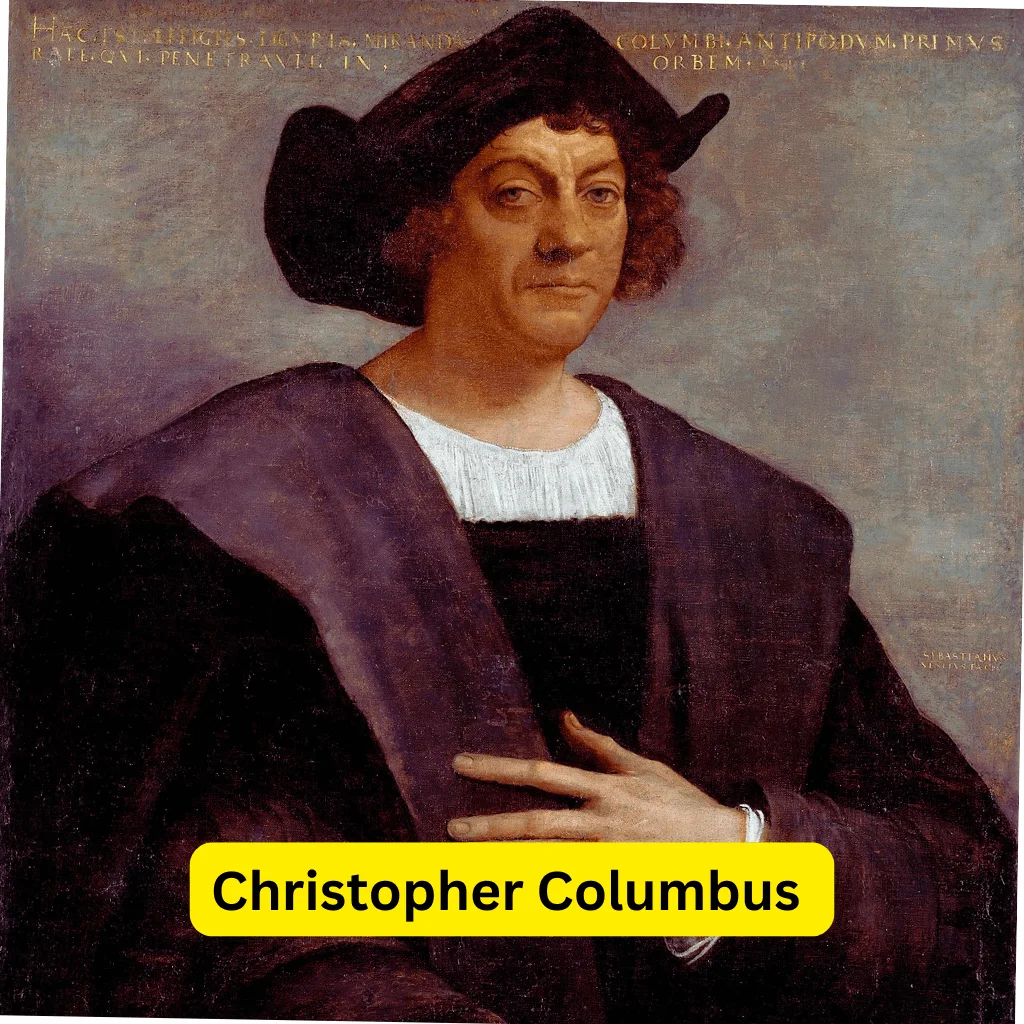
Christopher Columbus, an Italian navigator sailing under the Spanish crown, embarked on his historic voyage in 1492 with the goal of finding a westward route to Asia.
- First Voyage (1492): Columbus set sail with three ships—the Niña, the Pinta, and the Santa María—and landed in the Caribbean, mistakenly believing he had reached the outskirts of Asia.
- Subsequent Voyages: Over four expeditions, he explored parts of the Caribbean, including present-day Cuba, Hispaniola, and the Bahamas, establishing Spanish claims to the New World.
- Legacy: Though Columbus never reached Asia, his voyages initiated European colonization of the America and the Columbian Exchange, which dramatically reshaped the world.
John Cabot (c. 1450–c. 1500): England’s First Steps in the New World
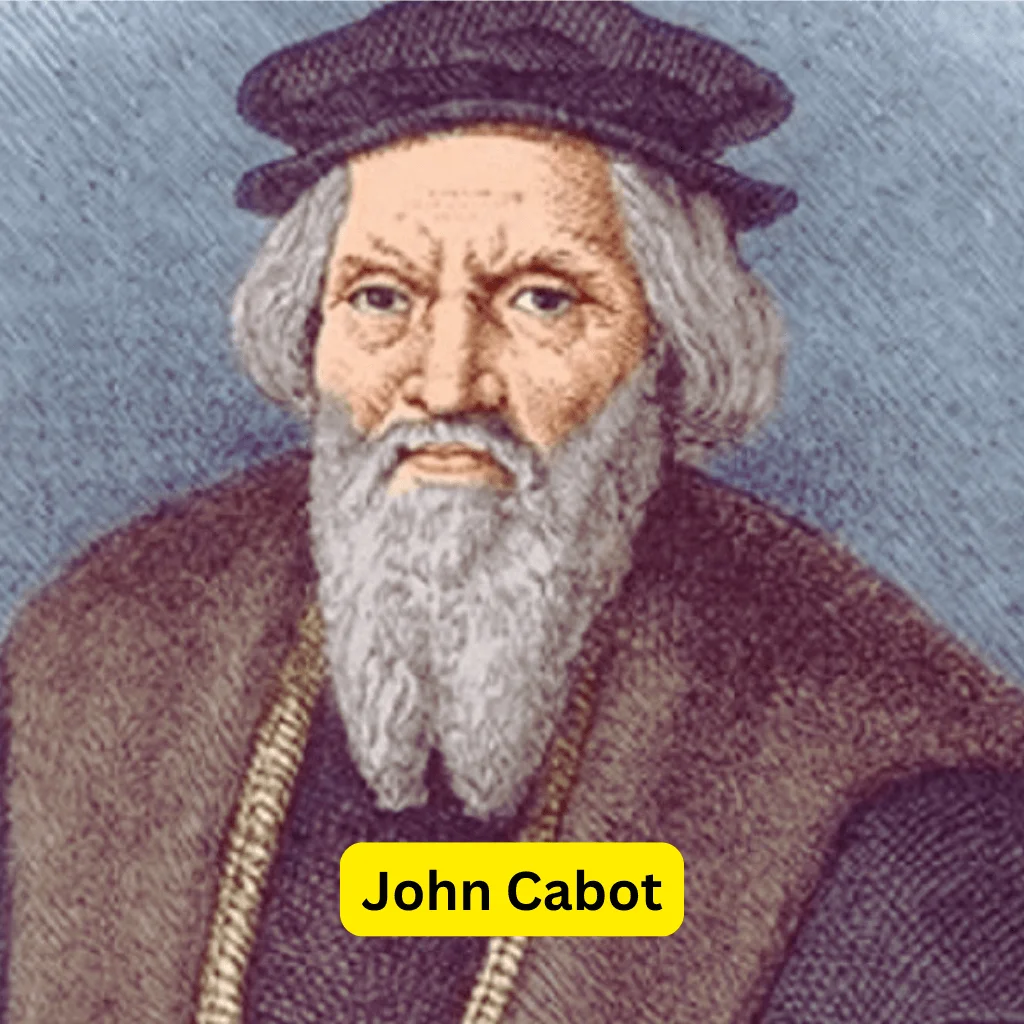
John Cabot, an Italian explorer sailing under the English flag, made one of the earliest claims to North America for England.
- 1497 Voyage: Commissioned by King Henry VII, Cabot sailed across the Atlantic and reached the coast of present-day Canada, possibly Newfoundland.
- 1498 Attempt: A second expedition aimed at further exploration, but Cabot likely perished at sea.
- Significance: His discoveries laid the groundwork for England’s later colonization efforts in North America.
Amerigo Vespucci (1454–1512): Naming the New World
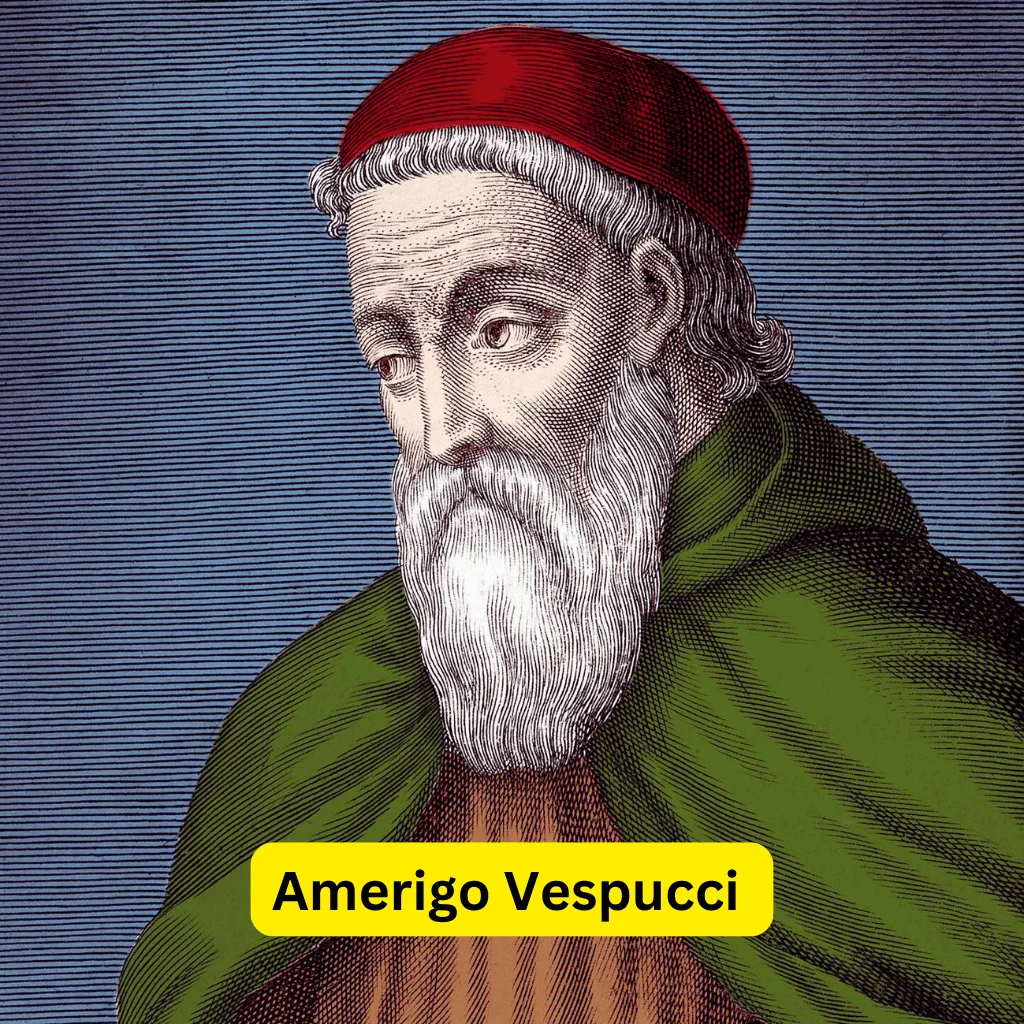
Amerigo Vespucci, an Italian explorer and cartographer, played a critical role in recognizing that the lands discovered by Columbus were not Asia but a new continent.
- Expeditions (1499–1504): Vespucci traveled along the coast of South America and identified it as a separate landmass.
- Mapmaking and Naming: German cartographer Martin Waldseemüller named the continent “America” in Vespucci’s honor in 1507.
- Legacy: His insights led to the realization that the America were distinct from Asia, changing European perspectives on global geography.
Ferdinand Magellan (1480–1521): The First Circumnavigation of the Globe
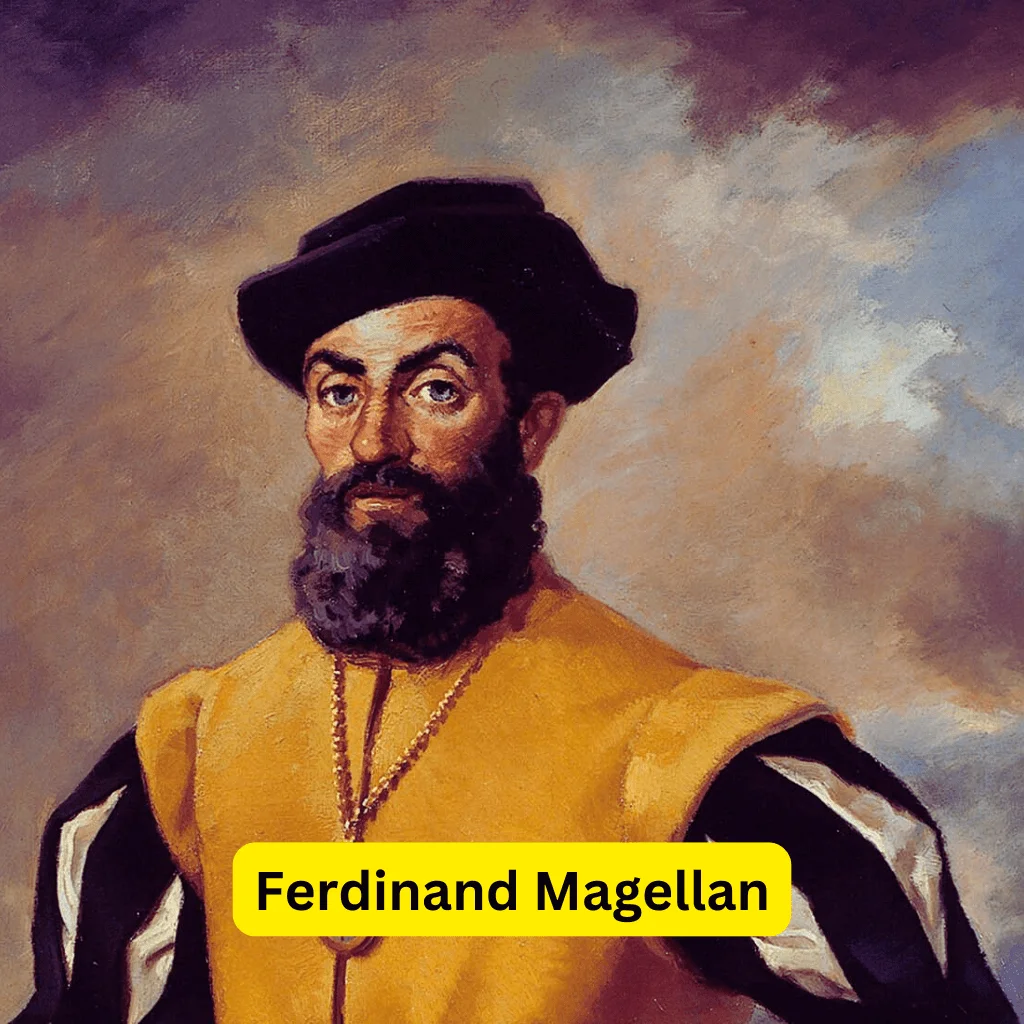
Ferdinand Magellan, a Portuguese explorer sailing for Spain, led the first expedition to circumnavigate the globe, proving the vastness of the Earth.
- 1519–1522 Voyage: Magellan’s fleet set out to find a westward route to the Spice Islands (present-day Indonesia). He navigated the treacherous Strait of Magellan at the southern tip of South America.
- Pacific Crossing and Death: He reached the Philippines but was killed in a conflict with local tribes. His crew, under Juan Sebastián Elcano, completed the journey back to Spain in 1522.
- Impact: The voyage demonstrated the full scope of the Earth’s size and opened new global trade routes.
Navigational Advances and Maritime Technology
The success of early European explorations was made possible by groundbreaking advancements in navigation and shipbuilding.
- The Magnetic Compass and Astrolabe
- Magnetic Compass: Originating from China, it allowed sailors to determine direction even in cloudy or open-sea conditions.
- Astrolabe: A device used to measure latitude based on the position of the stars and sun, enabling more accurate navigation.
- Cartography and Mapmaking
- The Renaissance saw a revolution in mapmaking, with the creation of portolan charts, which detailed coastlines and key landmarks for sailors.
- Ptolemaic Maps: The revival of ancient Greek geographic knowledge helped shape European navigation.
- The Caravel: A Revolutionary Ship Design
- Lightweight and Maneuverable: The caravel, pioneered by the Portuguese, combined square and lateen (triangular) sails, making it highly efficient for long voyages.
- Deep Hull and Cargo Capacity: These ships could withstand rough seas and carry significant supplies and cargo, facilitating long-distance exploration.
The early explorations of European powers were fueled by economic ambition, religious fervor, and political competition. Driven by key figures like Columbus, Cabot, Vespucci, and Magellan, these journeys reshaped the global landscape. Technological advancements in navigation and shipbuilding enabled these daring voyages, marking the beginning of a new era of discovery and colonization. These early efforts laid the foundation for the expansion of European empires, setting the stage for centuries of transatlantic interaction, trade, and conflict.
The Age of Conquest
The period of European conquest and colonization in the America reshaped the global order. From the late 15th to the 18th century, European nations competed to expand their influence, establish settlements, and exploit the New World’s vast resources. This era was marked by the fall of powerful indigenous empires, the establishment of colonial economies, and the transformation of indigenous societies.
Spanish Colonization
Spain was the first European power to establish a vast colonial empire in the America, driven by the pursuit of gold, the spread of Christianity, and imperial expansion.
Conquistadors and the Fall of Indigenous Empires (Aztec and Inca)
Spanish conquistadors, ambitious soldiers and explorers, played a central role in the conquest of the America. The most significant conquests included:
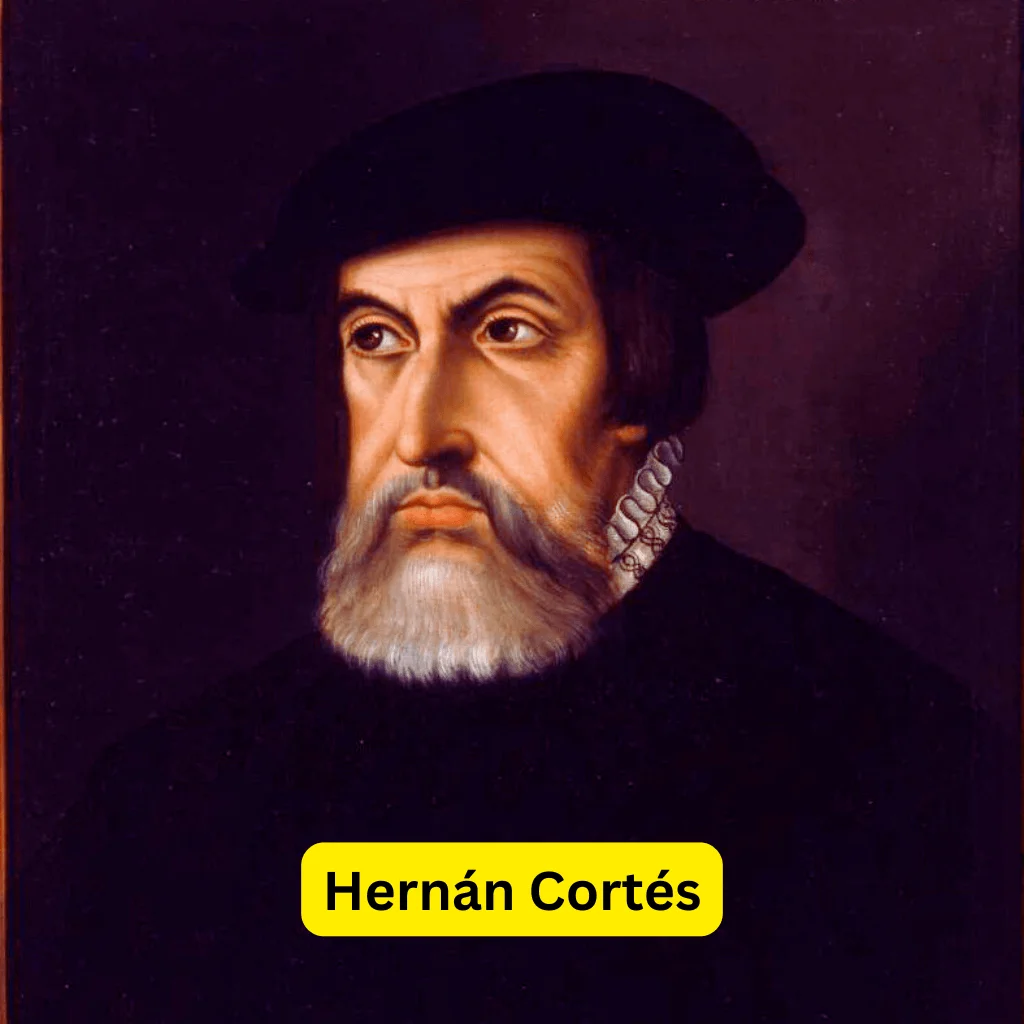
- The Fall of the Aztec Empire (1519–1521)
- Led by Hernán Cortés, the Spanish arrived in Mexico and formed alliances with local tribes who resented Aztec rule.
- The Spaniards took advantage of Montezuma II’s hesitation, eventually capturing and killing the Aztec emperor.
- The smallpox epidemic, brought by Europeans, decimated the native population, aiding Spanish victory.
- The Fall of the Inca Empire (1532–1533)
- Francisco Pizarro led the conquest of the Inca Empire in present-day Peru.
- After capturing and executing Emperor Atahualpa, Pizarro and his forces took control of the vast empire.
- Spanish rule introduced European governance, forced labor, and the destruction of Inca culture.
Establishment of Spanish Settlements (Florida, Mexico, Peru)
Spain’s territorial expansion led to the founding of key settlements:
- St. Augustine, Florida (1565): The oldest continuously inhabited European settlement in the United States.
- Mexico City (1521): Built over the ruins of Tenochtitlán, it became the capital of New Spain.
- Lima, Peru (1535): Established as the capital of Spanish South America, facilitating trade and administration.
The Encomienda System and Its Impact
- Definition: A labor system where Spanish colonists were granted control over indigenous populations in exchange for Christianizing them.
- Impact: Led to widespread forced labor, exploitation, and the destruction of indigenous societies.
- Abolition: Due to its cruelty, reforms like the New Laws of 1542 aimed to curb abuses, but exploitation persisted.
British Colonization
The British colonization of North America differed from Spanish efforts, focusing on permanent settlements, agriculture, and trade.
- Establishment of the Thirteen Colonies: The British established colonies along the Atlantic coast, beginning with:
- Jamestown, Virginia (1607): The first permanent English settlement, driven by tobacco cultivation.
- Plymouth Colony (1620): Founded by Pilgrims, seeking religious freedom.
- The Thirteen Colonies (1607–1733): Expanded to include colonies like Massachusetts, Pennsylvania, and Georgia.
- Relations with Native Americans
- Early Relations: Some cooperation existed, such as the Pilgrims’ alliance with the Wampanoag (Thanksgiving).
- Conflicts: The Powhatan Wars (1610s–1640s) and King Philip’s War (1675–1676) saw violent clashes over land.
- Displacement: As British settlements expanded, indigenous tribes were forced westward.
- Economic Activities: Tobacco, Cotton, and Trade
- Tobacco Plantations: Became a cash crop in Virginia and Maryland.
- Cotton and Slavery: The Southern colonies relied on enslaved African labor to produce cotton.
- Triangular Trade: The colonies participated in the trade of goods, enslaved people, and raw materials between Europe, Africa, and the America.
French Colonization
The French approach to colonization emphasized trade and alliances with indigenous peoples rather than conquest.
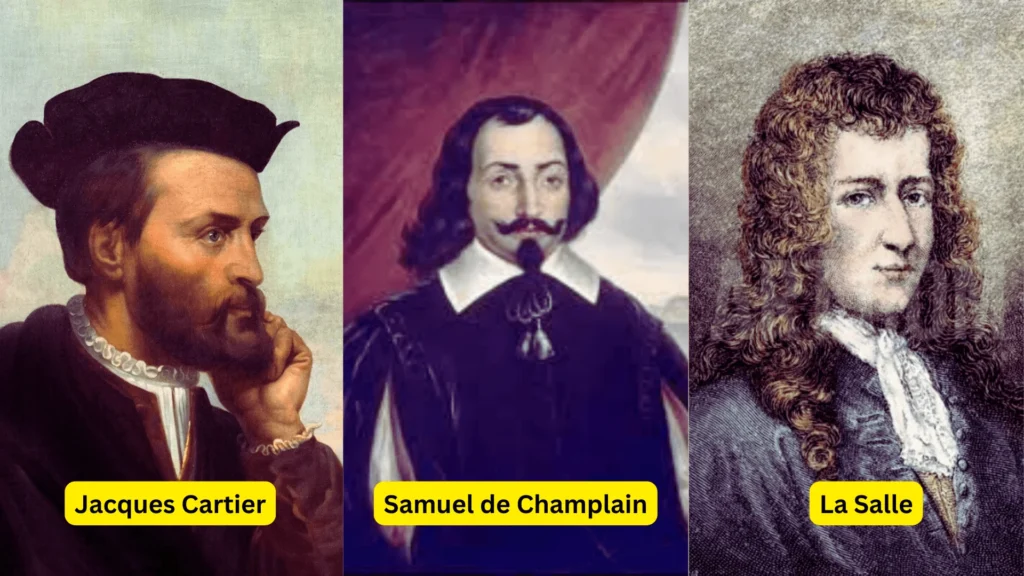
- Exploration of Canada and the Mississippi River
- Jacques Cartier (1534): Explored the St. Lawrence River, laying claims for France.
- Samuel de Champlain (1608): Founded Quebec, establishing a stronghold in Canada.
- La Salle (1682): Explored the Mississippi River, claiming Louisiana for France.
- Fur Trade and Relations with Indigenous Peoples
- Economic Focus: The French profited from the fur trade, partnering with the Huron and Algonquin tribes.
- Alliances: French explorers relied on native knowledge for survival and trade routes.
- Conflicts: The French faced hostilities with the Iroquois Confederacy, allies of the British.
- French Missions and Settlements
- Catholic Missions: Jesuit priests sought to convert indigenous peoples to Christianity.
- New Orleans (1718): Became a major French trading port.
- Limited Population Growth: Unlike Spanish and British colonies, French settlements remained small.
Other European Powers (Dutch, Portuguese, and Others)
While Spain, Britain, and France dominated colonization, other European nations also attempted to establish colonies.
- Dutch Exploration and New Amsterdam
- Henry Hudson (1609): Explored the Hudson River, leading to Dutch claims in North America.
- New Amsterdam (1625): Established on Manhattan Island, it became a key trading hub.
- British Takeover (1664): The Dutch lost control to the British, who renamed it New York.
- Portuguese Influence in Brazil
- Treaty of Tordesillas (1494): Divided South America, granting Brazil to Portugal.
- Sugar Plantations: Portugal developed a lucrative sugar economy, relying on African slaves.
- Colonial Capital, Salvador (1549): Became an administrative and trade center.
- Lesser-Known European Efforts
- Swedish Colonization (1638–1655): The short-lived New Sweden colony in Delaware focused on fur trade.
- Danish Caribbean Holdings: Denmark controlled islands like St. Thomas in the Caribbean for sugar production.
The Age of Conquest was a transformative period that reshaped the America. Spain, Britain, France, and other European powers carved out vast territories, subjugating indigenous populations and altering the region’s demographic, cultural, and economic landscape.
- Spain’s Legacy: Left a lasting impact on Latin America through language, religion, and governance.
- Britain’s Influence: Led to the foundation of the United States and Canada.
- France’s Approach: Created a unique French-influenced culture in parts of Canada and Louisiana.
- Other European Contributions: Though smaller in scale, Dutch, Portuguese, and other nations played key roles in shaping the New World.
The European conquest of the America was a story of ambition, conflict, and transformation. While it led to economic prosperity for European nations, it also resulted in the suffering and displacement of millions of indigenous and African peoples—a legacy that continues to shape the modern world.
Impact on Indigenous Populations
The arrival of European explorers and settlers in the America marked one of the most profound cultural and demographic shifts in world history. Indigenous societies, which had thrived for millennia, faced enormous challenges as European powers expanded their territories. While there were moments of cultural exchange and cooperation, the overall impact of colonization was devastating for Native American communities.
This article explores how indigenous populations were affected by European colonization, focusing on cultural interactions, the spread of diseases, and the ways in which indigenous peoples resisted and adapted to colonial rule.
Cultural Exchanges and Conflicts
Cultural Exchange: Introduction of New Goods and Practices
Colonization led to the exchange of goods, ideas, and technologies between Europeans and indigenous peoples, often referred to as the Columbian Exchange.
- New Crops and Livestock
- Europeans introduced wheat, sugarcane, rice, and coffee to the America.
- Horses, cattle, pigs, and sheep transformed indigenous lifestyles, particularly in the Great Plains, where the horse revolutionized hunting and warfare.
- In return, indigenous peoples introduced corn, potatoes, tomatoes, and tobacco to Europeans, dramatically impacting European diets and economies.
- Technology and Tools
- Indigenous peoples gained access to metal tools, firearms, and glass beads.
- Europeans learned from Native American agricultural practices, such as the “Three Sisters” farming technique (corn, beans, and squash).
- Religious and Spiritual Exchange
- Catholic missionaries sought to convert indigenous peoples to Christianity, sometimes through force.
- Indigenous spirituality and traditions influenced aspects of colonial life, but many native belief systems were suppressed.
Cultural Conflicts and Disruptions
While cultural exchange did occur, the relationship between indigenous populations and European colonizers was often fraught with conflict.
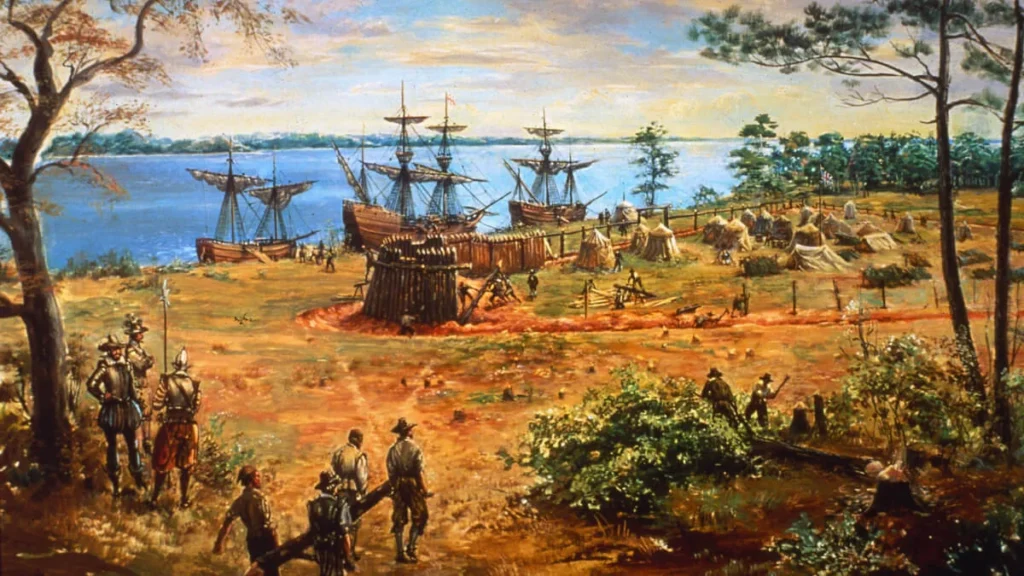
- Land Disputes and Forced Relocations:
- Europeans viewed land as property, while many indigenous cultures saw it as communal.
- Colonization led to the forced displacement of native tribes, particularly in North America and South America.
- Treaties were often signed under duress and later broken by European settlers.
- Religious Suppression and Assimilation:
- Spanish missionary programs forced indigenous peoples to abandon traditional spiritual practices.
- In North America, English settlers pressured Native Americans to adopt European customs and Christianity.
- Many indigenous children were taken from their families and placed in boarding schools, where they were forbidden to speak their native languages.
- Wars and Violent Clashes:
- The Pequot War (1636-1638) and King Philip’s War (1675-1676) in New England were brutal conflicts between Native Americans and British colonists.
- The Pueblo Revolt (1680) in present-day New Mexico saw indigenous groups temporarily drive out the Spanish.
- Spanish conquistadors used brutal tactics to suppress resistance in Mexico and South America, including the destruction of the Aztec and Inca empires.
Spread of Diseases and Demographic Changes
Perhaps the most devastating impact of European colonization was the introduction of Old World diseases, which indigenous populations had no immunity against.
- The Role of Epidemics
- European contact introduced deadly pathogens such as smallpox, measles, influenza, and typhus.
- Smallpox epidemics wiped out entire indigenous communities, sometimes before they even encountered European settlers.
- In Mexico, the native population fell from about 25 million in 1519 to less than 2 million by 1600 due to disease and warfare.
- Demographic Collapse
- Historians estimate that 90% of indigenous populations in the America perished within the first century of European contact.
- In North America, tribes such as the Cherokee, Iroquois, and Algonquin suffered massive population declines.
- In South America, the Inca Empire lost millions to disease, starvation, and forced labor under Spanish rule.
- Social and Economic Disruptions
- Loss of Elders and Cultural Knowledge: Epidemics disproportionately killed elders, who were the keepers of oral traditions and histories.
- Forced Labor Systems: Survivors of disease were often enslaved or forced into the encomienda system, working on Spanish plantations and mines.
- Depopulation and Migration: Some indigenous groups abandoned their traditional lands and moved to remote regions to escape colonization.
Resistance and Adaptation of Indigenous Communities
Despite suffering immense losses, indigenous peoples fought back, adapted, and found ways to survive under colonial rule.
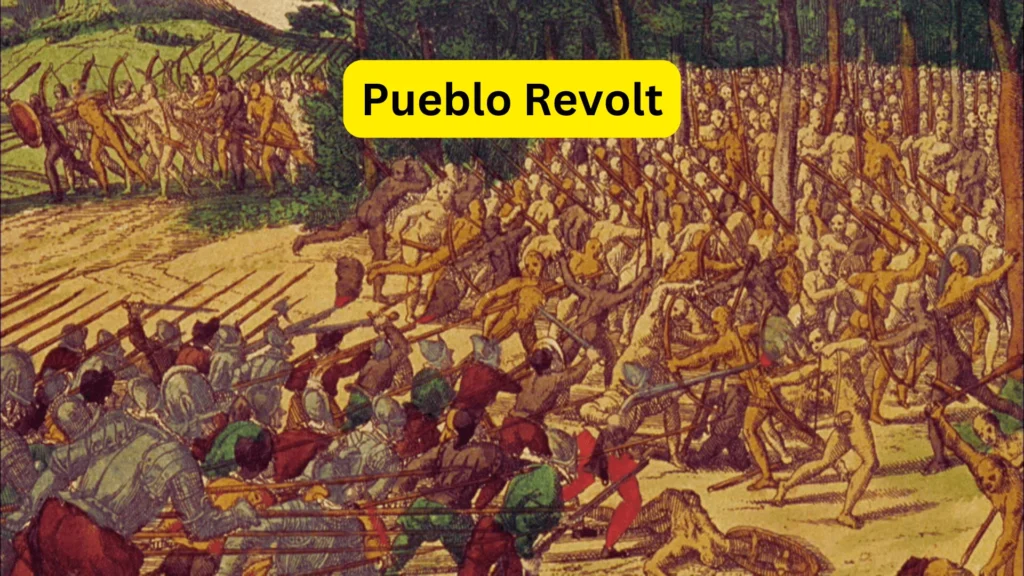
- Armed Resistance and Rebellions
- The Pueblo Revolt (1680): Led by Popé, the Pueblo people temporarily expelled the Spanish from New Mexico.
- The Anglo-Powhatan Wars (1610s–1640s): The Powhatan Confederacy fought against English encroachment in Virginia.
- Tecumseh’s Confederacy (early 1800s): In later years, Native American leader Tecumseh attempted to unite tribes against U.S. expansion.
- Adaptation to European Influence
- Use of European Technology: Many indigenous groups adopted firearms and horses to resist colonization or improve hunting.
- Engagement in Trade: Some tribes became essential trade partners with Europeans, exchanging furs, food, and knowledge.
- Selective Assimilation: Some indigenous leaders embraced aspects of European culture while maintaining their identity. For example, the Cherokee Nation adopted European farming techniques and created a written language.
- Survival and Cultural Resilience
- Preservation of Language and Traditions
- Indigenous communities continue to revive native languages, with schools teaching children their ancestral tongues.
- Traditional ceremonies, dances, and religious practices persist despite centuries of suppression.
- Modern Legal and Political Resistance
- Indigenous nations continue to fight for land rights, sovereignty, and recognition.
- In the U.S., Native American tribes operate casinos and businesses to rebuild economic independence.
- In Canada, the Truth and Reconciliation Commission acknowledges past injustices against indigenous peoples.
- Preservation of Language and Traditions
The impact of European colonization on indigenous populations was profound and often tragic. While the exchange of goods and ideas brought some benefits, the spread of disease, land dispossession, forced labor, and cultural suppression devastated native societies. Despite these hardships, indigenous peoples displayed remarkable resilience, resistance, and adaptation.
Today, Native American, First Nations, and Indigenous communities across the America continue to fight for justice, recognition, and cultural preservation, ensuring that their histories, languages, and traditions are not lost.
Economic Impact of Colonization
The colonization of the America by European powers had profound and lasting economic effects, shaping global trade, labor systems, and resource distribution. The Columbian Exchange facilitated the transfer of goods, animals, and diseases between the Old and New Worlds. The establishment of plantation economies led to the exploitation of natural resources and the rise of the transatlantic slave trade. Additionally, the principles of mercantilism governed colonial economic policies, ensuring that European nations maximized their wealth and power.
This article explores the economic consequences of colonization under three major themes: the Columbian Exchange, the development of plantation economies and slavery, and the transatlantic trade system driven by mercantilist policies.
The Columbian Exchange: Goods, Animals, and Diseases
The Columbian Exchange refers to the widespread transfer of plants, animals, culture, human populations, technology, and diseases between the America and Afro-Eurasia following Christopher Columbus’s voyages in 1492. This exchange reshaped economies worldwide and had both positive and devastating effects.
New World to Old World (The America to Europe, Africa, and Asia)
- Crops and Resources Introduced to Europe and Beyond:
- Maize (corn), potatoes, tomatoes, and chili peppers became staple foods in Europe and Asia, leading to population booms.
- Tobacco and cacao fueled new industries, becoming lucrative exports for European markets.
- Gold and silver, extracted from the America, enriched European economies and fueled global trade.
- Economic Significance:
- The introduction of nutrient-rich crops like potatoes and maize reduced famine in Europe and China.
- Silver from Spanish colonies in Peru and Mexico was used for trade with Asia, particularly in China’s economy.
Old World to New World (Europe, Africa, and Asia to the America)
- Livestock and Agriculture:
- Horses, cattle, pigs, and sheep transformed indigenous societies, particularly in North America, where the horse revolutionized Plains Indian cultures.
- European wheat, sugarcane, and rice were cultivated in the America, leading to the rise of plantation economies.
- Introduction of Diseases:
- European settlers unintentionally introduced smallpox, measles, influenza, and typhus, leading to catastrophic indigenous population declines.
- Some estimates suggest that up to 90% of indigenous people perished within the first century of European contact due to disease alone.
Establishment of Plantation Economies and Slavery
One of the most significant economic transformations resulting from colonization was the establishment of plantation economies, which relied on large-scale agriculture, forced labor, and cash crops for export.
- The Rise of Cash Crop Plantations
- European colonies in the Caribbean, Brazil, and the southern United States developed plantation economies that depended on exporting goods to European markets.
- Key cash crops included:
- Sugarcane (Caribbean, Brazil) – fueled Europe’s sugar industry.
- Tobacco (Virginia, North Carolina) – became a profitable commodity for Britain.
- Cotton (southern U.S.) – later became essential for European textile production.
- Coffee and cacao (South America and the Caribbean) – led to global consumer markets.
- The Role of Forced Labor and Slavery: The plantation system required large labor forces, leading to the expansion of slavery and other forced labor systems.
- Encomienda System (Spanish Colonies):
- Indigenous people were forced to work on Spanish farms, mines, and plantations under harsh conditions.
- The system was later replaced by African slavery due to the decline of indigenous populations.
- Transatlantic Slave Trade:
- European colonists turned to African slaves to sustain labor-intensive agriculture.
- The Middle Passage saw the forced migration of over 12 million Africans to the America.
- Slaves were treated as property, subjected to brutal conditions, and denied basic rights.
- Economic Consequences:
- Slavery created massive wealth for European nations, particularly Britain, Spain, Portugal, and France.
- African societies suffered depopulation and economic disruption due to the loss of their young workforce.
- The plantation economy set the foundation for racial hierarchies and systemic inequalities that persisted for centuries.
- Encomienda System (Spanish Colonies):
Transatlantic Trade and Mercantilism
The Structure of the Transatlantic Trade System
The transatlantic trade system linked Europe, Africa, and the America in a vast economic network known as the Triangular Trade.
- Leg 1 (Europe to Africa):
- European merchants traded manufactured goods (guns, textiles, and alcohol) for African slaves.
- Leg 2 (Africa to the America – The Middle Passage):
- African slaves were transported under horrific conditions to work on plantations.
- Leg 3 (America to Europe):
- Colonial goods (sugar, tobacco, cotton, coffee) were shipped to European markets.
This system created immense profits for European nations while devastating African and indigenous communities.
Mercantilism: European Economic Policies
Mercantilism was the dominant economic philosophy of European colonial powers from the 16th to 18th centuries. The goal was to maximize national wealth by controlling trade and resources.
- Colonial economies were designed to benefit the mother country.
- Colonies provided raw materials (sugar, tobacco, furs, gold, silver) and served as markets for European manufactured goods.
- European powers restricted colonial trade with other nations through laws like Britain’s Navigation Acts, ensuring that wealth flowed back to Europe.
Long-Term Economic Consequences
- Europe became wealthier, accumulating capital that fueled the Industrial Revolution.
- The America became deeply tied to export-driven economies, dependent on European demand.
- Slavery and plantation systems created economic disparities that persisted long after abolition.
The colonization of the America drastically reshaped the world’s economy. The Columbian Exchange facilitated the movement of crops, animals, and diseases, fundamentally altering global trade. The plantation economy led to the enslavement of millions and the rise of cash crop industries. The transatlantic trade system and mercantilist policies enriched European powers but came at an immense human cost.
While colonization fueled economic growth for European nations, it also resulted in exploitation, displacement, and lasting inequalities. The legacy of these systems can still be seen today in global trade patterns, economic disparities, and the lasting effects of slavery and indigenous displacement.
Religious and Cultural Influences of Colonization in America
European colonization of the America had profound religious and cultural consequences. The spread of Christianity, efforts toward cultural assimilation, and the legacy of European languages and customs reshaped indigenous societies and created long-lasting influences that persist to this day. While colonization introduced new religious and social structures, it also led to the suppression of indigenous traditions, often resulting in syncretism, where indigenous and European beliefs merged.
This article explores three major aspects of religious and cultural influence: the spread of Christianity and religious missions, cultural assimilation and syncretism, and the legacy of European languages and customs.
Spread of Christianity and Religious Missions
One of the primary goals of European colonization was the Christianization of indigenous peoples. Religious institutions, particularly the Catholic Church and Protestant missionaries, played a central role in the colonization process, aiming to convert native populations while also establishing European cultural dominance.
Catholic Missions: Spanish and French Colonies
- Spain and Portugal led aggressive efforts to spread Catholicism in the America.
- Missionaries, particularly from the Jesuits, Franciscans, and Dominicans, established missions—settlements that served as religious, cultural, and economic centers.
- Major Catholic missions were established in:
- Mexico and Peru – Spanish missionaries converted millions of indigenous people.
- California and the American Southwest – Spanish Franciscan missions, led by Junípero Serra, played a key role in colonization.
- French Canada and Louisiana – Jesuits sought to convert indigenous groups like the Huron and Algonquin.
Protestant Missions: British and Dutch Colonies
- British colonization was driven more by economic motives than religious conversion, but Puritans, Quakers, and Anglicans still sought to spread their faith.
- Protestant missions in the Thirteen Colonies focused on indigenous conversions, though they were often less forceful than Catholic efforts.
- The Dutch Reformed Church sought to convert indigenous peoples in New Amsterdam (New York) and the Dutch Caribbean.
Forced Conversion and Religious Resistance
- Many indigenous groups resisted conversion and maintained traditional spiritual practices.
- Some blended Christian and indigenous beliefs, leading to syncretism (discussed below).
- Colonizers often destroyed indigenous religious sites and replaced them with churches.
- The Spanish Inquisition was introduced in some colonies, punishing those who clung to traditional beliefs.
The Christianization of the America created lasting religious landscapes, with Catholicism becoming dominant in Latin America and Protestantism taking root in North America.
Cultural Assimilation and Syncretism
As European powers sought to establish control, they imposed language, dress, social structures, and customs on indigenous populations. However, rather than erasing native traditions entirely, colonization led to cultural syncretism—a blending of indigenous and European beliefs and practices.
European Cultural Imposition and Indigenous Adaptation
- European colonizers sought to “civilize” indigenous peoples, often forcing them to adopt European clothing, language, and legal systems.
- Boarding schools and church-run institutions were established to assimilate indigenous children into European ways of life, particularly in British and Spanish colonies.
- Indigenous leaders selectively adopted European customs while retaining native traditions, ensuring their cultural survival.
Syncretism: Blending of Religious and Cultural Traditions
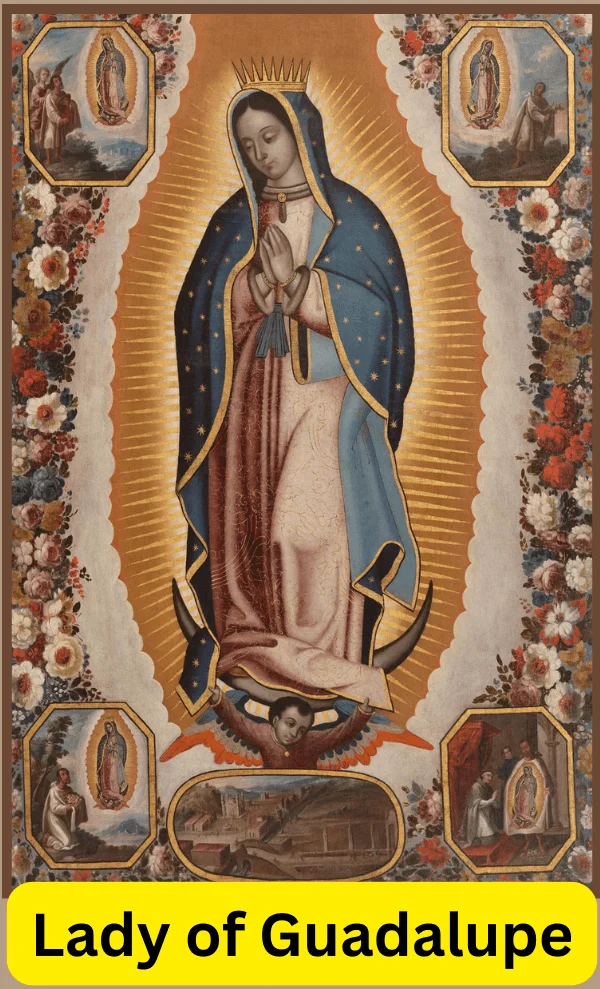
- Indigenous people incorporated Christian saints, rituals, and imagery into their existing belief systems.
- Examples of religious syncretism:
- Our Lady of Guadalupe (Mexico) – A blend of Catholic Marian devotion and indigenous Aztec religious imagery.
- Voodoo (Haiti), Santería (Cuba), and Candomblé (Brazil) – Merged African spiritual traditions with Catholic elements.
- Day of the Dead (Día de los Muertos) – A fusion of indigenous ancestor worship and Catholic All Saints’ Day celebrations.
Enduring Cultural Blending
- Food, music, and art blended European and indigenous influences:
- Latin American cuisine fused European, indigenous, and African ingredients.
- Guitar-based music traditions evolved from Spanish and indigenous influences.
- Many indigenous languages incorporated European loanwords, while new Creole languages emerged in the Caribbean.
Though colonization sought to impose European culture, indigenous peoples actively resisted and reshaped colonial influences, creating new, hybrid cultural identities that persist today.
Legacy of European Languages and Customs
European colonization left a permanent linguistic and cultural imprint on the America. European languages, legal systems, and social customs replaced indigenous traditions in many regions.
Spread of European Languages
- Spanish, Portuguese, English, and French became dominant languages across the America.
- Indigenous languages declined, but many survived, often merging with European vocabulary.
- Spanish remains the primary language in Latin America.
- Portuguese became dominant in Brazil.
- English and French took hold in North America and the Caribbean.
- Creole languages developed in the Caribbean, blending European and African linguistic influences.
Legal and Political Influence
- European powers introduced Western legal systems:
- British common law influenced the United States and Canada.
- Spanish and Portuguese civil law shaped Latin American legal traditions.
- French legal codes influenced parts of Canada, the Caribbean, and Louisiana.
- European political structures influenced governance:
- Monarchical rule and colonial administrations became standard.
- European property laws replaced indigenous communal land ownership, leading to land dispossession.
European Social and Cultural Traditions
- European dress, architecture, and education systems replaced indigenous customs in many regions.
- Christian holidays became widely celebrated, while many indigenous festivals were suppressed or integrated into Christian traditions.
- European colonization introduced Western scientific knowledge, literature, and art, reshaping indigenous societies.
Despite these changes, indigenous cultures survived and adapted, preserving traditions through oral history, resistance movements, and modern revitalization efforts.
The Shift from Exploration to Colonization
The period of European exploration, which began in the late 15th century, gradually transitioned into full-scale colonization as European powers sought to establish permanent settlements and expand their influence in the New World. Initially driven by the desire for new trade routes and wealth, exploration soon gave way to territorial expansion, resource extraction, and political control. The shift was influenced by formal agreements, the development of colonial administrations, and rivalries between European powers.
Treaty of Tordesillas and Its Impact
Background: The Need for Division
By the late 15th century, Portugal and Spain had emerged as the dominant naval powers exploring the America, Africa, and Asia. Their competition for new territories led to conflicts over claims in the New World. To avoid open conflict, Spain and Portugal turned to the Pope to mediate the division of new lands.
The Treaty of Tordesillas (1494)
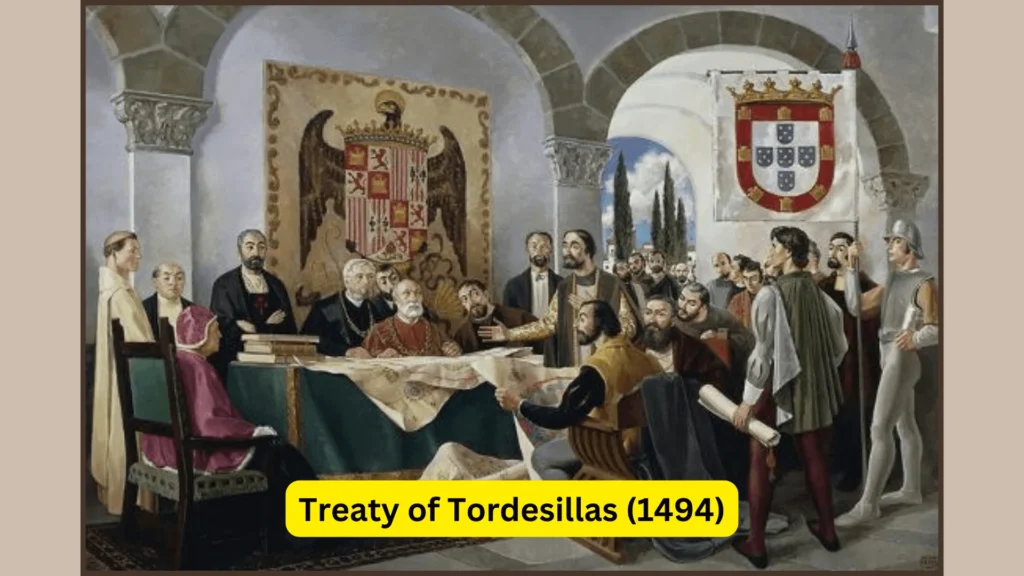
- Brokered by Pope Alexander VI, the treaty divided the non-European world between Spain and Portugal along an imaginary meridian located 370 leagues west of the Cape Verde Islands.
- Spain received lands west of the line, covering most of the America.
- Portugal was granted lands east of the line, which included Brazil (later discovered in 1500) and territories in Africa and Asia.
Consequences of the Treaty
- Spanish Dominance in the America: Spain gained control of vast territories, leading to the establishment of powerful colonial empires in Mexico, Peru, and the Caribbean.
- Portuguese Control of Brazil: Though unintended, the treaty ensured Portuguese influence in South America, where Brazil became a key part of its empire.
- Exclusion of Other European Powers: The treaty was designed to benefit only Spain and Portugal, which angered other emerging European nations like England, France, and the Netherlands. These nations later ignored the treaty and challenged Iberian dominance, leading to conflicts and colonial expansion.
The Treaty of Tordesillas was a turning point that transformed exploratory voyages into structured colonization, with Spain and Portugal establishing the first European colonies in the New World.
The Development of Colonial Governments
Early Colonial Administration Models
As European nations transitioned from exploration to colonization, they established various governance models to control their territories. These included:
- Spanish Viceroyalties: Spain established viceroyalties in New Spain (Mexico) and Peru, ruled by viceroys directly appointed by the Spanish Crown.
- Portuguese Captaincy System: Brazil was divided into hereditary captaincies, granted to Portuguese nobles who governed on behalf of the Crown.
- French Trading Colonies: The French focused on fur trading and relied on alliances with indigenous groups rather than large-scale settlements.
- English Self-Governing Colonies: The English granted charters to private companies (e.g., Virginia Company), which had autonomy in governing their settlements.
Colonial Laws and Regulations
To maintain control over their colonies, European powers imposed strict governance structures:
- Spanish Laws of the Indies regulated all aspects of colonial life, from land distribution to the treatment of indigenous populations.
- English Navigation Acts restricted colonial trade, ensuring that resources benefited the British economy.
- French Intendant System centralized power under royal officials in Canada and the Caribbean.
The Role of the Church and Military
- The Catholic Church played a significant role in Spanish and Portuguese colonies, overseeing education, land management, and the treatment of indigenous peoples.
- Military forces were stationed in key locations to defend against indigenous resistance and rival European attacks.
Over time, these administrative systems transformed temporary trading posts into permanent colonies, ensuring European dominance in the America.
European Rivalries and Conflicts in the New World
As European nations expanded their colonies, competition over territory, resources, and trade routes led to numerous conflicts in the America.
Anglo-Spanish Rivalry and the Defeat of the Spanish Armada (1588)
- England challenged Spain’s dominance in the New World by funding privateers like Sir Francis Drake to raid Spanish ships.
- In response, Spain launched the Spanish Armada to invade England, but its defeat in 1588 marked the decline of Spanish naval supremacy.
- After this, England increased its efforts to establish colonies in North America and the Caribbean.
The Dutch vs. The Spanish and Portuguese
- The Dutch established trading posts in New York (New Amsterdam), the Caribbean, and Brazil, challenging Iberian control.
- The Dutch-Portuguese War (1602–1663) resulted in Dutch victories in Asia and Brazil, weakening Portuguese influence.
The French vs. The British
- Both nations fought for control over Canada, the Mississippi Valley, and the Caribbean.
- The French and Indian War (1754–1763)—part of the global Seven Years’ War—ended with Britain taking control of French Canada.
Treaty of Paris (1763): The Reshaping of the America
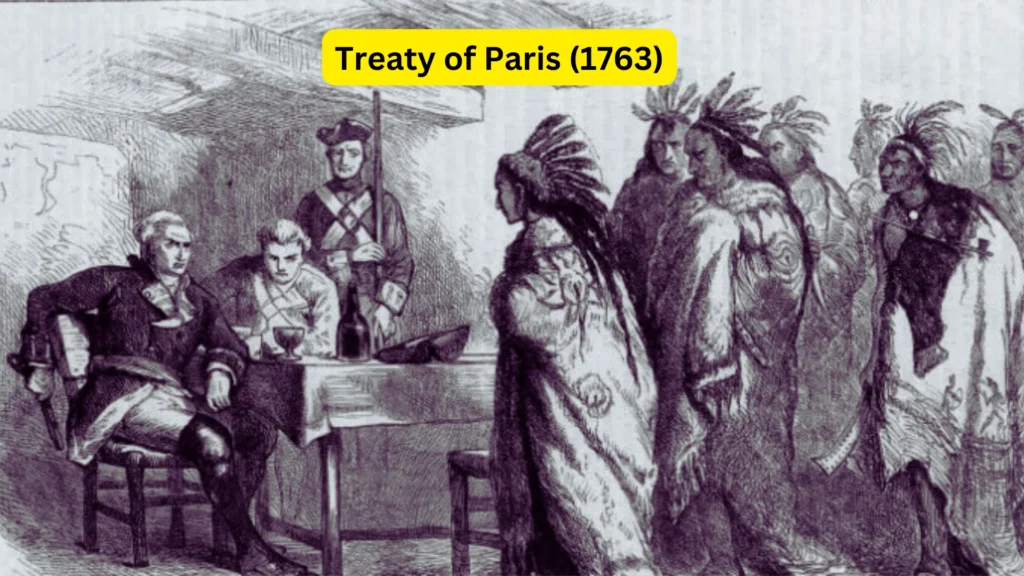
- France lost most of its North American territories, ceding Canada to Britain and Louisiana to Spain.
- Spain gave Florida to Britain but retained its vast South American holdings.
- In North America, Britain became the most powerful colonial power.
These conflicts shaped the colonial map and ensured that European rivalries dictated the political and economic future of the New World.
Legacy of European Colonization
The legacy of European colonization in the America is a complex and enduring influence that has shaped the cultural, social, and economic fabric of the modern world. European powers, particularly Spain, Portugal, Britain, France, and the Netherlands, established lasting systems of governance, culture, and trade that continue to resonate today. This legacy has left a profound impact on indigenous populations, social structures, and global economic systems. In this section, we explore the lasting cultural and linguistic impacts, the changes in social structures and power dynamics, and the long-term economic effects and development resulting from European colonization.
Lasting Cultural and Linguistic Impacts
European Languages and Education Systems
One of the most significant aspects of European colonization was the spread of European languages across the America. Today, languages such as Spanish, English, French, and Portuguese are spoken throughout the Western Hemisphere, becoming the official languages of numerous countries. The linguistic landscape of Latin America, the Caribbean, and North America was deeply influenced by European powers, with each language shaping local identities and cultures.
- Spanish is the most widely spoken language in Latin America, resulting from centuries of Spanish rule in regions like Mexico, Central America, and South America.
- English became the dominant language in the United States, Canada, and parts of the Caribbean, particularly after British colonization.
- Portuguese is the primary language of Brazil, a direct consequence of Portuguese colonization in South America.
- French remains the official language in parts of Canada (Quebec) and several Caribbean islands, following French exploration and settlement.
Additionally, European models of education, religion, and legal systems were imposed in the colonies. Western institutions such as universities, hospitals, and legal codes were established, fundamentally transforming local societal structures and introducing concepts of governance, law, and citizenship that mirrored European traditions.
Cultural Syncretism and the Fusion of Traditions
Colonization also led to a process of cultural assimilation and syncretism in which indigenous traditions merged with European customs, creating unique cultural blends across the America.
- Religion was a central element of this cultural fusion. The spread of Christianity resulted in the blending of indigenous religious practices with Christian rituals. For instance, in Mexico and Peru, the worship of indigenous deities was often combined with Catholic saints, leading to a unique form of syncretic religion.
- Art, music, and cuisine also reflect this syncretism. Indigenous ingredients such as corn, potatoes, and tomatoes were incorporated into European culinary traditions, which led to the creation of new dishes like tacos, tamales, and empanadas.
- African influences, due to the transatlantic slave trade, further enriched the cultural landscape, particularly in Caribbean and Brazilian music (e.g., salsa, samba, and bossa nova) and religious practices (e.g., Candomblé in Brazil).
These cultural and linguistic transformations remain central to the identity of many nations today and serve as a reminder of the interconnectedness of the world through the legacy of European colonization.
Changes in Social Structures and Power Dynamics
The Creation of a Rigid Class System
European colonization introduced a hierarchical social structure that was based on race, ethnicity, and economic status. This social stratification not only shaped the daily lives of people but also created lasting divisions in society.
- In Spanish and Portuguese colonies, the Casta system was implemented, which categorized people based on their racial and ethnic background. The system placed Europeans at the top, followed by Creoles (people of European descent born in the America), Mestizos (mixed European and Indigenous descent), and Indigenous peoples and Africans at the bottom.
- British colonies had a different approach but still maintained a class-based structure, where English settlers and their descendants held the highest power, with indentured servants and enslaved Africans occupying the lowest positions in society.
These racial and social hierarchies created a legacy of inequality and discrimination that persists in many parts of the America, where economic opportunities and social mobility were often limited by race and ethnicity.
The Displacement and Marginalization of Indigenous Populations
The effects of colonialism on indigenous communities were severe. As Europeans established settlements and claimed territories, millions of Indigenous people were displaced, killed, or forced into labor. The forced labor systems, such as the encomienda system in Spanish colonies, gave European settlers control over vast swathes of land and Indigenous labor.
- Indigenous communities were often forced into adopting European customs, and their traditional political structures were undermined.
- The separation of land ownership and the imposition of European economic systems led to the dispossession of native peoples, further entrenching power imbalances that have shaped the social and economic realities of the America for centuries.
These social changes not only disrupted existing power structures but also led to the formation of new elites and the marginalization of native populations. The legacy of colonial rule is visible today in the ongoing struggles of indigenous groups to regain land, preserve culture, and achieve equal rights.
Long-Term Economic Effects and Development
The Foundation of Global Trade Networks
The economic legacy of European colonization is perhaps most evident in the establishment of the global trade networks that emerged as a result of the Columbian Exchange and the exploitation of the America.
- European powers extracted vast quantities of natural resources from the America, such as gold, silver, sugar, tobacco, and cotton, which fueled the economic growth of Europe and changed the global balance of wealth.
- The transatlantic slave trade provided cheap labor for the plantation economies in the Caribbean, South America, and North America, leading to the rise of global capitalist systems.
- Colonization also contributed to the development of mercantilist policies, where colonies were seen as sources of raw materials for the mother country, leading to economic dependency and a global trading system that benefited European economies for centuries.
The Rise of Economic Inequality
While European nations profited immensely from the exploitation of colonial resources, many colonial subjects—especially indigenous people and African slaves—suffered economic exploitation. The wealth generated from colonization largely enriched the European aristocracy and urban merchants, while the labor force in the colonies remained impoverished and disenfranchised.
- The plantation economies in the America, dependent on slave labor, were major contributors to the development of the modern capitalist system, but they also perpetuated economic inequality that continues to have repercussions today.
- The legacy of colonialism is still visible in many parts of the world, where former colonies often face economic challenges, such as poverty, underdevelopment, and inequality, linked to centuries of exploitation.
The Long-Term Effects on Development
While some regions of the America, particularly the United States and Canada, saw rapid industrialization and economic growth, other parts of Latin America and the Caribbean remained mired in economic dependency and stagnation.
- The concentration of wealth in the hands of a few elites and the economic structures built during colonial times contributed to the unequal development seen in many former colonies.
- In the long run, colonial economic practices led to the perpetuation of poverty and limited opportunities for economic diversification in many countries, hampering their development in the post-colonial era.
The legacy of European colonization in the America is multifaceted and profound, with lasting impacts on cultural practices, social structures, and economic systems that continue to shape the region today. While colonial powers introduced new systems of governance, religion, and trade, they also left behind deep-seated inequalities, cultural divides, and economic challenges. Understanding this legacy helps us grasp the complex realities of modern society in the America and sheds light on the historical forces that continue to influence global relations.
Conclusion & FAQs
European colonization of the America, from the late 15th to the 18th century, created a lasting and complex legacy. It brought advancements in agriculture, medicine, and culture, but also caused immense suffering, displacement, and inequalities. The Columbian Exchange introduced new crops like maize and potatoes, benefiting global diets, while European farming reshaped landscapes. However, these gains came at the cost of indigenous populations, who were decimated by violence and disease, and the enslavement of Africans.
Colonization led to racial hierarchies that continue to affect societies today, particularly in issues of race, land ownership, and inequality. European languages and Christianity became dominant, while indigenous cultures and languages faced erosion. The economic systems established during colonization contributed to modern capitalist economies but also left enduring disparities.
Today, the impacts of colonization are still felt in many countries, with ongoing struggles for indigenous rights and cultural preservation. Addressing these historical injustices is crucial for creating a more inclusive and equitable future. Understanding the complexities of colonization helps us value cultural diversity and work toward healing and justice for affected communities.
